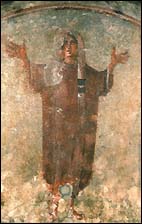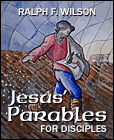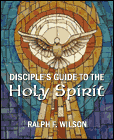Bible Study
New / Special
Jesus
Maturity
Encouragement
Good News
Church
Communion
Prayer
Christian Symbols
Scholarly Articles
Miscellany
Way of the Cross
Holidays
Christmas
Easter
Thanksgiving
Pentecost
St. Patrick's Day
New Year's Day
Steps to Peace with God
Year of St. Paul
About Us
Podcasts
Contact Us
Dr. Wilson's Books
Donations
Watercolors
Site Map
Christian Articles Archive
Lifting Hands in Worship
by Dr. Ralph F. Wilson
 Orante figure from the Catacomb of Priscilla, Cubicle of the Velata, Rome (second half of the third century).This pose of arms lifted in prayer is found in thousands of figures in the catacombs, representing a soul at peace in paradise. |
Lifting hands to the Lord in the Bible expresses two distinct ideas: supplication and blessing.
Lifting Hands in Supplication
A gesture common to many cultures is stretching forth the hands to implore another person to help, to give something, or to come. An example is found in Isaiah 65:1-2: "I said , 'Here am I, here am I,' to a nation that did not call on my name. I spread out my hands all the day to a rebellious people"2 (cf. Proverbs 1:24; Job 30:24; Jeremiah 4:31; Lamentations 1:17).
In a similar way, hands are extended for prayer in the direction of God's dwelling. Dedicating the temple, Solomon "stood before the altar of the Lord ... and spread 3 forth his hands toward heaven ...." (1 Kings 8:22; cf. vs. 54; 2 Chronicles 6:12, 13). He also asks God to honor prayers made toward the temple: "... Whatever prayer, whatever supplication is made by any man or by all thy people Israel, each knowing the affliction of his own heart and stretching out his hands toward this house ... hear thou in heaven thy dwelling place, and forgive, and act ..." (1 Kings 8:38- 39; cf. 2 Chronicles 6:29-30). David calls out, "Hear the voice of my supplication as I cry to thee for help, as I lift up my hands toward thy most holy sanctuary" (Psalm 28:2; cf. also 134:2). Most often, however, hands are lifted up to God in heaven.
Hands express the inner man. Desperate for some response from God, David says, "I stretch out my hands to thee; my soul thirsts for thee like a parched land" (Psalm 143:6; cf. vs. 8). Hands mirror the soul stretched out to touch God, "... for to thee, O Lord, I lift up my soul" (vs. 8; cf. 25:1; 86:4).
Lifted hands must not mask sin. Worship offered to God while still practicing iniquity is an abomination (cf. Ps 40:6-8; 50:7-23; 51:16-19; Is 1:11-18). Defiled lives must be cleansed by repentance: "When you spread forth your hands, I will hide my eyes from you; even though you make many prayers, I will not listen; your hands are full of blood. Wash yourselves; make yourselves clean ...." (Isaiah 1:15-16; cf. 59:1-3). Rather we are to lift up "holy hands without anger or quarreling" (1 Timothy 2:8). The prophet Jeremiah admonishes the Israelites mourning the destruction of Jerusalem, "Let us search and try our ways, and turn again to the Lord! Let us lift up our hearts with our hands to God in the heavens" (Lamentations 3:40-41, KJV).
The lifting of the hands so characterizes prayer in the Bible that it becomes a metonymy, a symbol for supplication without the need to identify it as prayer. For example, Jeremiah urges, "Lift your hands to him for the lives of your children ..." (Lamentations 2:19; Psalm 44:20; and perhaps Lamentations 1:17). To lift the hand to God means invoking His help.
Lifting Hands in Blessing
Yet hands are not only lifted in supplication. They are also lifted to offer a blessing to God.
The custom of the laying on of hands underlies the use of hands in blessing.4 The laying on of hands was understood to confer or impart something. One's sins, for instance, were transferred to the sacrifice through laying on of hands (Leviticus 1:4; 16:21-22). More often, however, the hands conveyed a gift or blessing. Ordination bestowed authority, consecration, or special gifts (Numbers 27:18-23; Deuteronomy 34:9; Acts 6:6; 13:3; 14:23; 1 Timothy 4:14; 1:18; 2 Timothy 1:6). The Holy Spirit Himself was sometimes conveyed by the laying on of hands (Acts 8:17-18; 19:6). Jesus commonly imparted the blessing of healing through His hands (Matthew 8:1-3, 14-15; 9:20, 25, 29; Luke 4:40; etc.). Jacob pronounced a blessing on Ephraim and Manasseh by laying on his hands (Genesis 48:14-15) and so Jesus blessed the little children (Mark 10:16). To bless an individual, the person laid his hands on him. To bless a group, hands were lifted and extended over them,5 as in the priestly blessing (Leviticus 9:22) and Jesus' blessing of the disciples at His ascension (Luke 24:50).
Lifting of hands in praise to God derives from this understanding of imparting a blessing.6 David lovingly calls to his faithful God: "So I will bless thee as long as I live; I will lift up my hands and call on thy name" (Psalm 63:4). Temple worshipers are exhorted, "Come, bless the Lord, all you servants of the Lord, who stand by night in the house of the Lord! Lift up your hands to the holy place and bless the Lord!" (Psalm 134:1-2). David sees such heart worship as the kernel of more formal worship: "Let my prayer be counted as incense before thee, and the lifting up of my hands as an evening sacrifice!" (Psalm 141:2). Lifting the hands to honor and bless God expresses love for Him (Job 11:13; Psalm 68:31) and His commandments (119:48). When the covenant is renewed in Jerusalem after the Exile, the whole congregation participates: "Ezra blessed the Lord, the great God; and all the people answered, 'Amen, Amen,' lifting up their hands; and they bowed their heads and worshipped the Lord with their faces to the ground" (Nehemiah 8:6).7 Even nature blesses the Lord: "... The deep gave forth its voice, it lifted its hands on high" (Habakkuk 3:10).
In a series of complex passages we see the concept of hands uplifted in prayer merged with lifting hands to impart. In Egypt, Moses stretches out his hands to God to end the plague of thunder and hail (Exodus 9:29, 33).8 In the wilderness battle with Amalek, as Aaron and Hur held up Moses' hands the Israelites were victorious, but when Moses' hands grew weary the Amalekites gained the advantage (Exodus 17:11-12).9 Yet in each of these passages "the rod of God" seems to be in Moses' hand (9:22-23; 17:9). While prayer seems to be indicated, we also see hands imparting God's deliverance. Moses' hand becomes the hand of God to bless and set free His people much the same way Jesus' hand loosed those Satan had bound (Luke 13:10-16).
Lifting Hands Then and Now
From the Old Testament scriptures it is obvious that believers commonly prayed and praised while lifting their hands. The First Letter to Timothy assumes the practice among males in Christian assemblies as late as 60 A.D.: "I desire then that in every place the men should pray, lifting holy hands without anger or quarreling" (2:8). A Christian sarcophagus carving depicts person with hands lifted in prayer, attesting that the practice was characteristic of Christian prayer in the Third Century A.D.10 Yet it is strange to find no references to lay lifting of hands in prayer in Rabbinic writings.11 Jewish writers explain the cessation of this prayer form in the synagogue as a reaction against the prevalence of the custom among Christians.12 The practice of lifting the hands survives today in Western Christian and Jewish traditions primarily in the priestly or pastoral blessing of the people.13
Pentecostals, however, have revived the ancient practice of lifting the hands in worship because they have sought to emulate the Biblical models. In contrast, childhood instruction to fold little hands in prayer (probably to keep them out of mischief) finds no antecedent in Scripture.
Our hands are reflective of our being. Many of us, like the proverbial Italians, cannot talk without our hands. As people begin to yield their hands in expression to God, there often is a corresponding release in their worship.
Our own culture suggests meaningful gestures which communicate these various expressions. Palms lifted up might express openness, invitation, surrender. Reaching out signifies entreaty, supplication, and dependence. Hands extended palms out may symbolize extending a blessing to God much as a minister's benediction with hands stretched over the congregation imparts a blessing to them.
We must never allow lifting our hands to become an empty form; they are to express the inner being to God. As we use our hands to bless God may there be a fresh release of expression from our hearts in prayer, worship, and love to God. "Thus will I bless thee while I live: I will lift up my hands in thy name" (Psalm 63:4, KJV).
Notes
- There are 28 verses which clearly refer to lifting the hands in blessing or supplication. If lifting of Moses' hands (or rod in his hand) is included as prayer, then another 11 verses may be added. In light of the multitude of references to lifting hands in worship, the lack of in-depth treatment in the scholarly literature is surprising.
- Unless otherwise noted, all quotations are from the Revised Standard Version of the Bible.
- Two main Hebrew verbs are used to describe the lifting of hands:
nasa -- "to lift up" (Psalm 28:2; 63:4; 119:48;
134:2; Habakkuk 3:10; Lamentations 2:19; 3:41; a related noun
is used in Psalm 141:2) and paras -- "to spread out,"
sometimes translated "to stretch out" (Exodus 9:29,
33; 1 Kings 8:22, 38, 54; 2 Chronicles 6:12, 13, 29; Job 11:13;
Psalms 44:20; 143:6; Ezra 9:5; Isaiah 1:15; Jeremiah 4:31). Other
verbs are rus -- "to run, quickly stretch out"
(Psalm 68:31), rum -- "to raise, lift" (Exodus 17:11),
shatah--"to spread out" (Psalm 88:9); shalah -- "to
send, stretch out" (Job 30:24), and nata -- "to extend,
stretch out" (Exodus 9:22). The noun mo`al -- "lifting"
(Nehemiah 8:6) derives from the root `ala -- "to go
up."
The word "hand" usually translates either yad -- "hand" or kap -- "the palm of the hand, hand (opened or turned upward so as to expose the hand in contrast with yad 'hand' in general, whether open or closed in a grasp or fist)" (Gleason L. Archer, Jr., in Theological Wordbook of the Old Testament [abbreviated TWBOT], R. Laird Harris, Gleason L. Archer, Jr., and Bruce K. Waltke, editors [Chicago: Moody Press, 1980], vol. 1, p. 452). The words seem to be used interchangeably on the subject of lifting hands in prayer and worship, yad 11 times, kap 17 times.
Psalm 77:2 is difficult. Translators must choose between forcing the verb nagar -- "pour, flow, run" to mean "stretch out, extend" (so all modern translations), or forcing the noun yad -- "hand" to yield a figurative sense: "sore" (KJV) or "strength" (so Leonard J. Coppes in TWBOT, vol. 2, p. 553). - There is considerable literature on the laying on of hands. Some of the more helpful references are: Eduard Lohse, "cheir," in Theological Dictionary of the New Testament, G. Kittel and G. Friedrich, eds., G. W. Bromiley, tr. (Grand Rapids: Eerdmans, ET 1964-1974, 1933-1972), 9:424-437; David Daube, The New Testament and Rabbinic Judaism (London: University of London, 1956), pp. 224- 246; G. W. H. Lampe, The Seal of the Spirit (London: Longmans, Green, and Co., 1951), pp. 223-231; and J. K. Parratt, "The Laying on of Hands in the New Testament: A Re-examination in the Light of Hebrew Terminology," Expository Times 80 (1969), pp. 210-214.
- The present practice of extending one's hand toward the person being prayed for is a natural extension of this principle.
- Clapping the hands is used in Psalm 47:1 in rejoicing before God. Clapping is also attributed to the floods (Psalm 98:8) and the trees of the field (Isaiah 55:12) as nature praises the Lord. Clapping was used in this sense to rejoice before a newly crowned king (2 Kings 11:12). However, some sorts of clapping held a negative connotation (cf. Job 27:23; 34:37; Lamentations 2:15; Ezekiel 25:6; Nahum 3:19).
- Here we see a combination of lifting the hands in blessing and the hand (singular) lifted up to God to solemnly swear before Him. Cf. Genesis 14:22; Exodus 6:8; Numbers 14:30; Deuteronomy 32:40; Ezekiel 20:5; 36:7; 47:14; etc. Lifting the right hand to swear in court survives in our culture.
- Exodus 7:19; 8:5-6, 16-17; 10:12, 13, 21, 22; 14:16, 21, 26, 27; 15:12; cf. Joshua 8:18-19, 26; Isaiah 49:22; Acts 4:30.
- Jewish and Christian commentators have traditionally interpreted Moses' uplifted hands as an act of prayer (Mishnah, Rosh Hashanah 3:8; Calvin, etc.). So C. F. Keil and F. Delitzsch, Commentary on the Old Testament (Grand Rapids: Eerdmans, 1976, reprint), in loc. Brevard S. Childs (The Book of Exodus, Philadelphia: Westminster Press, 1974, p. 310-317) and others deny that prayer is involved, but suggestions of magic or the hands as instruments of mediating amoral power are unconvincing.
- A photograph is found in C. K. Barrett, The Pastoral Epistles (New Clarendon Bible series; Oxford: Clarendon Press, 1968), p. 53. Figures called oranti were found in catacomb frescos, usually in a standing positon with arms extended. See the article on "Oranti" in William Smith and Samuel Cheetham, A Dictionary of Christian Antiquities (New York: Kraus Reprint Co., 1968; reprint of 1880 edition), II, 1463f. See more at "Orante," Early Christian Symbols, JesusWalk.com, 2006.
- So Dr. Elieser Slomovic, Associate Professor of Rabbinic Literature, University of Judaism, Los Angeles, California. Private communication, April 30, 1985.
- Abraham E. Millgram, Jewish Worship (Philadelphia: Jewish Publication Society of America, 1971), pp. 356-357; and Avrohom Chaim Fuer, Tehillim: A New Translation with a Commentary Anthologized from Talmudic, Midrashic and Rabbinic Sources (Brooklyn: Mesorah Publications, Ltd., 1977-80, 5 vols.), 4:1094.
- The lifting of hands continued in the church beyond the Third Century primarily in the monastic movement. There are remnants of the practice in liturgical churches. In the present Roman Catholic mass the priest lifts his hands, shoulder high, palms out, during the Eucharistic prayer. In the Greek Orthodox mass the priest lifts his hands above his head while saying, "Let us lift up our hearts to the Lord." In more liturgical churches the minister lifts up the bread and cup in offering much as a pastor might lift collection plates in dedication.
Copyright © 2025, Ralph F. Wilson. <pastor![]() joyfulheart.com> All rights reserved. A single copy of this article is free. Do not put this on a website. See legal, copyright, and reprint information.
joyfulheart.com> All rights reserved. A single copy of this article is free. Do not put this on a website. See legal, copyright, and reprint information.
 |

|
In-depth Bible study books
You can purchase one of Dr. Wilson's complete Bible studies in PDF, Kindle, or paperback format -- currently 48 books in the JesusWalk Bible Study Series.
Old Testament
- Abraham, Faith of
- Jacob, Life of
- Moses the Reluctant Leader
- Joshua
- Gideon
- David, Life of
- Elijah
- Psalms
- Solomon
- Songs of Ascent (Psalms 120-134)
- Isaiah
- 28 Advent Scriptures (Messianic)
- Daniel
- Rebuild & Renew: Post-Exilic Books
Gospels
- Christmas Incarnation (Mt, Lk)
- Sermon on the Mount (Mt 5-7)
- Luke's Gospel
- John's Gospel
- Seven Last Words of Christ
- Parables
- Jesus and the Kingdom of God
- Resurrection and Easter Faith
- Apostle Peter
Acts
Pauline Epistles
- Romans 5-8 (Christ-Powered Life)
- 1 Corinthians
- 2 Corinthians
- Galatians
- Ephesians
- Philippians
- Colossians, Philemon
- 1 & 2 Thessalonians
- 1 &2 Timothy, Titus
General Epistles
Revelation
Topical
 To be notified about future articles, stories, and Bible studies, why don't you subscribe to our free newsletter, The Joyful Heart, by placing your e-mail address in the box below. We respect your
To be notified about future articles, stories, and Bible studies, why don't you subscribe to our free newsletter, The Joyful Heart, by placing your e-mail address in the box below. We respect your